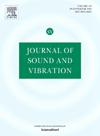Realization of a wideband three-axis horizontal vibration isolator with adjustable stiffness and damping
IF 4.3
2区 工程技术
Q1 ACOUSTICS
引用次数: 0
Abstract
Horizontal vibration isolators (HVIs) designed to be on the verge of elastic instability offer many opportunities for isolating a variety of vibration-sensitive instruments, such as atomic force microscopes and laser/optical systems from ambient excitations at very low frequencies (0.5 – 5 Hz). These HVI systems are designed to have very low natural frequencies and can achieve quasi-zero-stiffness (QZS) in the horizontal axes when they support payloads close to their maximum payload-carrying capacities. Payloads of different sizes and weights necessitate to have adjustable stiffness and damping to operate in very wide bandwidths. To address these issues, a QZS HVI using axially compressed elastic columns is designed, optimized and fabricated. The system has adjustable natural frequencies in three axes (two translational and one torsional) via a string tensioning mechanism. Besides, the system enables the torsional natural frequency to be adjusted independently of the two translational natural frequencies by means of novel column sliding mechanisms that can change the radial positions of the elastic columns from the center axis of the system. Amplitude-dependent damping and stiffness characteristics of this variable natural frequency system are determined under various axial preload conditions. The system also involves an adjustable eddy current damper to effectively suppress low frequency resonance peaks. Finally, a methodology is proposed to modify the ideally clamped boundary conditions of the elastic columns, resulting in very good agreement between the analytical, numerical, and experimental results. The results show that the proposed HVI can achieve bandwidths between 1.6 – 311 Hz in the translational axes and 0.7 – 311 Hz in the torsional axis for payloads between 0 – 45 kg, providing a very large isolation bandwidth in three axes for a wide range of payload masses.
求助全文
约1分钟内获得全文
求助全文
来源期刊

Journal of Sound and Vibration
工程技术-工程:机械
CiteScore
9.10
自引率
10.60%
发文量
551
审稿时长
69 days
期刊介绍:
The Journal of Sound and Vibration (JSV) is an independent journal devoted to the prompt publication of original papers, both theoretical and experimental, that provide new information on any aspect of sound or vibration. There is an emphasis on fundamental work that has potential for practical application.
JSV was founded and operates on the premise that the subject of sound and vibration requires a journal that publishes papers of a high technical standard across the various subdisciplines, thus facilitating awareness of techniques and discoveries in one area that may be applicable in others.
 求助内容:
求助内容: 应助结果提醒方式:
应助结果提醒方式:


